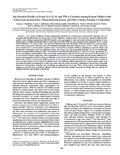| dc.description.abstract | In a study of children having polyparasitic infections in a Schistosoma haematobium–endemic area, we
examined the hypothesis that S. haematobium–positive children, compared with S. haematobium–negative children (anti-
soluble worm antigen preparation [SWAP] negative and egg negative) have increased systemic production of pro-inflammatory cytokines (interleukin [IL]-6, tumor necrosis factor [TNF]-a) and decreased down-regulatory IL-10. A total of 804 children, 2–19 years of age, were surveyed between July and December 2009 and tested for S. haematobium, Plasmodium falciparum, filariasis, and soil-transmitted helminth infections. Plasma levels of IL-6, TNF-a, and IL-10
were compared for S. haematobium–positive and S. haematobium–negative children, adjusting for malaria, filaria, and
hookworm co-infections, and for nutritional status, age group, sex, and geographic location. IL-10 was significantly
elevated among children infected with S. haematobium, showing bimodal peaks in 7–8 and 13–14 years age groups. IL-
10 was also higher among children who were acutely malnourished, whereas IL-10 levels were lower in the presence of
S. haematobium–filaria co-infection. After adjustment for co-factors, IL-6 was significantly elevated among children of 5
–6 years and among those with P. falciparum infection. Lower levels of IL-6 were found in malaria–hookworm co-infection.
High levels of TNF-awere found in children aged 11–12 years regardless of infection status. In addition, village of residence
was a strong predictor of IL-6 and IL-10 plasma levels. In adolescent children infected with S. haematobium
, there is an associated elevation in circulating IL-10 that may reduce the risk of later morbidity. Although we did not find a direct link between S. haematobium infection and circulating pro-inflammatory IL-6 and TNF-a levels, future T-cell stimulation studies may provide more conclusive linkages between infection and cytokine responses in settings that are endemic for multiple parasites and multiple co-infections. | en_US |

